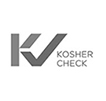Types of Coffee Beans
- Light Roast: From South America featuring flavor notes of citrus, chocolate, and cream
- Medium Roast: From Colombia with tastes of Brazil nuts, grapefruit, and oak
- Medium-Dark Roast: From Central & South America highlighting local flavors of brown sugar, hazelnut, and plum
- Dark Roast: From South America with French inspiration featuring smoky raspberry, dark chocolate, and anise flavors
- Organic Roast: From Papua New Guinea with savory flavors featuring bell pepper, cedar, and lemony acidity
- Decaf Roast: From South America invoking sweet, baking tastes like molasses, caramel, and spice
Once you’ve selected one of our house blends, we’ll precisely package to your exact specifications. We can package your coffee blend with custom branding into cups for Keurig, Nespresso pods, compostable pods for Keurig, one-cup filter pods, cold brew pitcher packs or portion packs and traditional bags. With our state-of-the-art facility and advanced inventory management system, we can develop and package your custom coffee in weeks.
Make Your Own Coffee Blend
Blending coffee is a great option to ensure your product always has a consistent flavor profile and helps expand your brand to new customers. To offer you the best options, we stock a variety of high-quality single-origin coffee options, so you can achieve a dynamic and diverse flavor profile. This variety serves as the perfect canvas for your coffee customization journey.
Joe’s Garage Coffee provides single-origin coffee from all around the world including:
- Brazil: Chocolate, stone fruit, nutty, dusty finish
- Colombia: Brazil nut, grapefruit, oak
- Costa Rica: Dried apricot, brown sugar, nut butter, green grape
- Honduras: Almond, chocolate, honey
- Mexico: Citrus, chocolate, clean finish
- Sumatra: Earthy, woody, spicy
- Organic Papua New Guinea: Bell pepper, cedar, lemon
Want us to benchmark a competitor’s coffee? Simply send us samples and our sensory panel will match it. Once we’ve developed the single-origin or blend that best fits your ideal flavor profile, we can also infuse your coffee with popular flavors, including traditional French vanilla, peppermint or pumpkin spice. We also offer unique flavors like salted caramel and chocolate creme brûlée. Don’t forget about our mix, blend, and infuse services for adding functional ingredients to any brew.
3 Things to Consider When Creating Your Coffee Blend
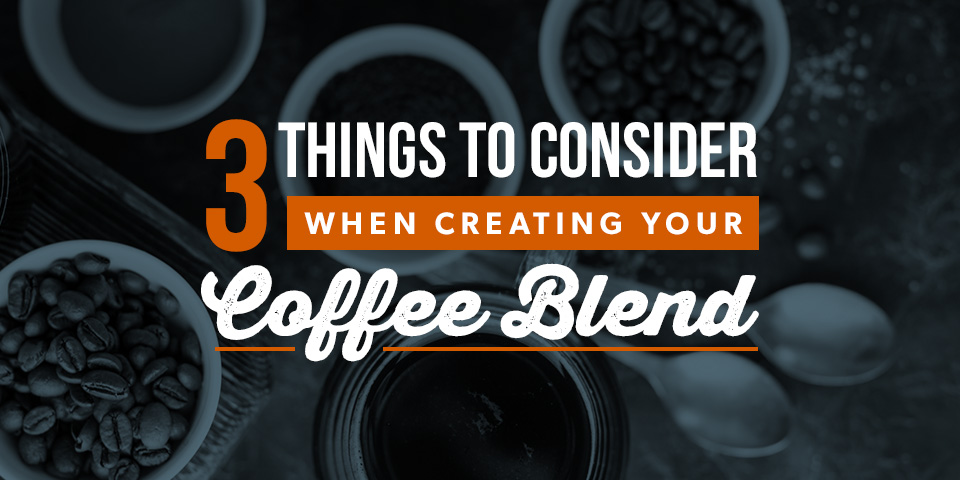
Coffee blends are vital for coffee brands looking to provide consistent offerings year-round. If you’re wondering how to create the perfect product for your business, Joe’s Garage Coffee has you covered. We can provide all the answers you need to feel confident in your unique coffee blend.
We’ll break down the differences between single-origin and blend coffees, discuss the benefits of blends, review the components of a coffee blend, and explain how to develop consistent, high-quality blends your customers return to time and time again.
Read on to discover how to craft profitable coffee blends that deliver consistent flavor profiles for your target market.
Single-Origin Coffee vs. Blends
We all know coffee beans grow in numerous locations worldwide, and where they come from impacts their flavors. Let’s dive into the difference between single-origin and blends.
Single-origin coffee uses beans from only one origin — one place, country, or micro-climate — to make a cup of coffee. You can trace a proper single-origin coffee back to one specific farm in which the beans experienced the same climate and weather conditions to develop an exact flavor profile. The taste is pure, unique, and delicious. The specialty coffee community celebrates single-origin coffees for their intrinsic flavors.
Coffee blends combine at least two different coffee beans from more than one location or farm. Every coffee farm in each country produces a unique bean with a world of flavor, and the combination of different coffee beans creates a unique flavor that sets each blend apart. A blend can consist of beans from multiple varieties, origins, or species.
Coffee blends can contain many different coffees. Using multiple distinct bean types can mask the individual beans’ unique flavor and complexity. For a stable flavor foundation, most blends use one coffee bean from a single location to create the base, sometimes as much as 75% of the mixture.
Some folks assume roasters blend coffees as an attempt to get rid of past-crop beans, move leftover product, or hide less-desirable flavors, not understanding the truth of how blends work and why they’re beneficial. Here’s the real reason roasters develop blends — thoughtfully crafted blends meet consistent customer demand. Customers will repeatedly purchase a signature product with a dependable flavor profile available year-round.
Coffee Blend Origin
Blending coffee is all the rage now, but when and where did coffee roasters start the blend trend? History tells us that coffee blends have been around for a long, long time.
For centuries, rich-flavored coffee cultivated in the dry-climate Arabian Peninsula traveled from the famous Yemeni port of Mocha to destinations in every corner of the globe. In the 17th century, Dutch colonists introduced the coffee plant to the warm, damp climate of Indonesia, producing coffee prized for its lowered acidity and deep body of flavor.
Dutch merchants returning to Europe started combining Yemeni beans with coffee grown on the Indonesian island of Java to create the first coffee blend in history, Mocha Java, which continues its popularity today. The tradition of coffee blending was born, allowing roasters to create unique and delightful flavor profiles that have captivated coffee enthusiastic for centuries.
Benefits of Coffee Blends Over Single-Origin Coffee
Single-origin coffees have unique profiles, yet their availability can be seasonal — and therefore limited. Coffee blends offer your customers a familiar favorite that is always available.
Coffee blend benefits abound.
- Blends can create better flavor profiles. Combining multiple beans results in a dynamic brew that is better than a single coffee can produce on its own. A customized blend emphasizes the best notes of each coffee component, adding more balance and complexity to the flavor profile.
- Blends cater to a broader audience. Blend adjustability allows you to create a more agreeable flavor for a bigger market. Blends take the edge off harsh or acidic flavors in individual coffees. Pairing a bold, apple-acidic Guatemalan with a smoother Indonesian bean mellows the intensity to appeal to a broader audience.
- Blends produce a consistent product. Instead of distributing one pound of four different coffees, blending them would create four pounds of one consistent product. Consistent blends make moving your product easier over a period of time.
- Blends reduce issues with quality and supply. Blend consistency provides reliable quality. Blends deliver a dependable flavor that won’t waver from season to season. Because blending can produce larger quantities of a given product, you’ll never run out of ample stock.
- Blends boost brand association. By developing signature coffee blends, your customers will associate a one-of-a-kind flavor with your brand that only you can provide. A high-quality blend links an in-demand product with your brand, increasing brand definition, recognition, and loyalty.
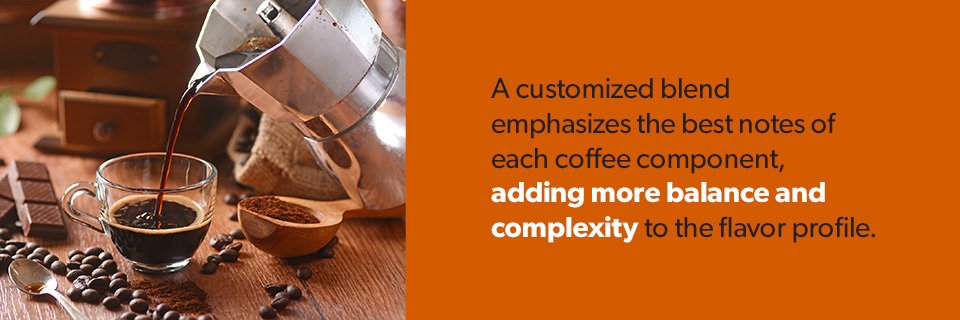
Challenges of Creating a Blend of Coffee
Crafting a balanced blend is an art and a science. It takes years of practice, experience, and expertise to understand which coffee combinations, mix ratios, and roast levels result in the flavor notes you seek for your customized blend.
Before selecting beans for your custom blend, the first challenge is determining the flavor base. If you’re not sure where to begin, consider these tried-and-true coffee blend types to get a feel for how different bean combinations create specific tastes.
- Black and tan. Named for the contrasting tones of the roasted beans, a black-and-tan blend mixes dark-roast and light-roast coffees for a medium flavor body.
- Mocha Java. The oldest known coffee blend remains a customer favorite. Blending beans from Yemen and Indonesia creates a smooth, rich coffee with deep cocoa notes.
- Melange. A melange blend mixes several coffees at various roast levels. The acidity of lighter roasts combined with the bitterness of darker roasts produces a complex and stable flavor.
Once a delicious blend is made, the work continues. Even with all the careful purchasing strategies and planning in the world, sometimes supply issues happen due to reasons outside anyone’s control. You may need to replace one of the component coffees because it’s run out or because the beans aren’t roasting quite the same way they did last year.
The coffee experts at Joe’s Garage Coffee have the development process and know-how to pivot with unexpected supply shifts. Our sensory panel creates and brews your custom coffee blend, documenting its flavor, cup quality, and balance. We’ll work with you to adjust samples to your satisfaction to ensure your blend maintains consistent, dependable quality.
3 Considerations for Your Coffee Blend
With millions of coffee beans worldwide, you could make countless coffee blends. If you’re not sure where to begin crafting a quality blend, we’ve got you covered. Hone these three factors — flavor profile, bean ratio, and roasting style — and watch customers keep coming back for more of your signature blend.
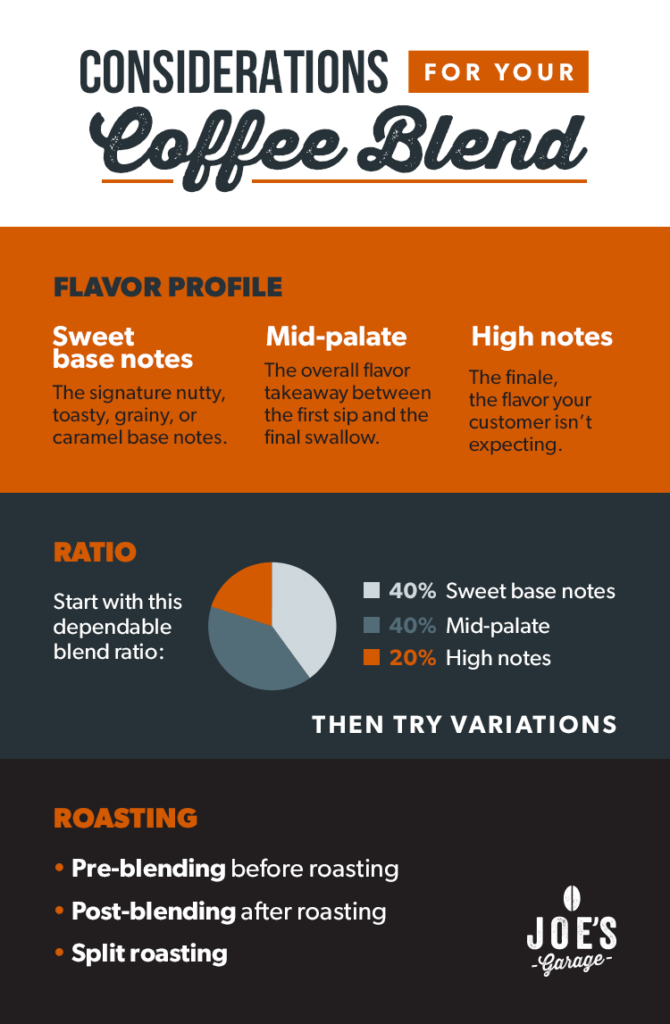
1. Flavor Profile
Every flavor profile includes three high-level points that steer the direction of your final taste.
- Sweet base notes. When temperatures hit 150 to 200 degrees Celsius during the roasting process, a chemical reaction occurs between the amino acids and natural sugars found in coffee known as the Maillard reaction stage. This reaction develops the signature nutty, toasty, grainy, or caramel base notes.
- Mid-palate. Most of the coffee drinker’s taste journey is the mid-palate experience. The mid-palate is the overall flavor takeaway between the first sip and the final swallow. Beverages that miss the mark mid-palate are “hollow.” To remedy this, add an acidic bean component with juicy, stone fruit notes.
- High notes. Floral aromas or citric acidity characterize a blend’s high notes in many light-roast blends. High notes aren’t only for light brews — you can incorporate them in any blend. Kenyan, Ethiopian, and some South American beans are valuable for their notable bright notes.
The trick to crafting an intriguing blend is nailing these three elements — finding that sweet base, rounding out a pleasant mid-palate journey, and adding the right high note to set your brew apart. Fortunately, you can accomplish a distinctive blend without combining wildly different bean origins.
To make your combination unique, start with a reliable sweet base, such as a Colombian bean with a chocolatey note, or choose a coffee sourced from regions known for taking on more intense flavor profiles during the roasting process, such as Mexican or Brazilian beans. Then, look for the perfect sip-to-swallow experience, which is the flavor your customer will enjoy from the first sip to the empty cup. Add depth to the mid-palate taste with a fruity bean. The green-grape acidity of Sumatra or stone fruit undertone of Brazilian beans would work wonderfully.
Finally, choose the finale or high note — the flavor your customer isn’t expecting. Add a surprising citrus twist from Mexico or underscore the nuttiness found in Colombian beans. For a delicate floral finish, look to coffees with lavender, rose, and elderflower notes.
2. Ratio
It’s up to you how much you want one bean to stand out. For instance, wine has one identifiable flavor with undertones that take the prominent flavor to the next level. Complement chocolatey or nutty coffee beans with fruity undertones from Costa Rica or an earthy richness from Sumatra. After you decide the types of coffee you want to include in your blend, you’ll enter the trial-and-error phase to determine the best ratio for each bean type.
Use balanced amounts of your sweet base and mid-palate beans for the majority of your blend. High notes can quickly take over your flavor profile, so it’s best to create a strong, sweet base and mid-palate foundation, then add in the high notes.
Start with this dependable blend ratio:
- 40% sweet base notes
- 40% mid-palate
- 20% high notes
Remember, this is your brand’s blend, so the precise ratios are entirely up to you. There will be back-and-forth changes and coffee waste at this stage of the blending process, and that’s OK. This ratio stage is crucial, so take the time to test and refine an enjoyable blend. Experiment with different ratios and compare the difference. Use the 40:40:20 ratio as a baseline, then try variations — reduce the high note intensity with 45:45:10, up the citric punch with 30:30:40, or be adventurous with a 60:20:20 mix.
Test small batches and log your results until you find that perfect combination that works to nail your target taste profile.
3. Before, After, or Split Roasting
As a coffee roaster’s experience grows with selecting component coffees and fine-tuning bean ratios, blends can be enhanced further by roasting choice — before, after, or split roasting. Different roasting approaches improve the aroma and flavor in specific ways. The question is, how should you roast them for your signature blend? Ultimately, the decision depends on your goals.
- Pre-blending before roasting. Pre-blending is mixing the different coffee components into one batch when the beans are green, then roasting the pre-blended beans together simultaneously.
- Post-blending after roasting. Post-blending involves roasting each coffee component as a separate batch, then mixing the roasted beans to form the blend.
- Split roasting. The more complex Neapolitan technique involves separating coffee beans into different sections based on their density or size, not origin. After roasting each section separately to bring out its best characteristics, blend all the roasted beans.
The most significant advantage of pre-blending is the guarantee of a consistent batch size, which creates consistency in the roast. One challenge of blending before roasting is a lowered level of refinement over how the roast affects each bean type. A carelessly monitored roasting process can create variations in the different coffee components’ densities and moisture levels, affecting the blend’s mid-palate taste takeaway.
The benefit to post-blending is more control over the roasting of each bean type, so you can carefully calibrate the roast levels and achieve excellent results. Blending after roasting allows for more diverse roasting combinations, such as a blend of light-roast and dark-roast beans. Remember, roasting each component in varying sizes may give you a limited batch size consistency. Post-blending is an excellent choice if you know you’ll have varying batch sizes for each coffee type.
Split-roasting takes a skilled hand to master, but the results are worth the difficulty. By roasting each density or size as a separate batch, beans can roast as evenly as possible to develop their full roasting potential.
How to Trial Your Coffee Blend
Now that you have a viable coffee blend, it’s time to taste the coffee as the customer will experience it. Use the blend to create various drinks commonly made by your customer base. Think about the user’s experience — will your customer purchase their beverage at a café or retailer, or purchase your beans online to prepare their drinks at home?
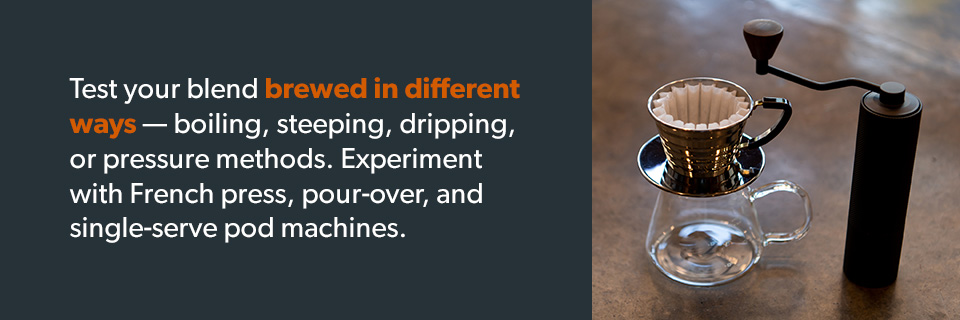
Test your coffee in numerous ways.
- Brew method. Try your blend brewed in different ways — boiling, steeping, dripping, or pressure methods. Experiment with French press, pour-over, and single-serve pod machines. We manufacture private label cups for Keurig, including recyclable options, and one-cup filter pods for food service applications.
- Espresso. Discerning espresso lovers desire a strong flavor profile. Ensure your espresso delivers with robust flavor. Our private label pods for Nespresso are compatible with Nespresso’s Original Line brewer models.
- Drink style. In addition to the classic espresso, try your blend prepared as various coffee drink styles — Americano, macchiato, cappuccino, cafe latte, mocha, and breve.
- Additives. Test your blend with half-and-half, whole, 2%, and 1% milk. Oat, coconut, hemp, almond, rice, and cashew milk varieties are increasingly popular coffee additions. Test these additives with and without sweeteners.
- Sweeteners. Examine your blend’s taste with brown, raw, and white sugar, plus honey, syrups, and molasses. Also test artificial sweeteners such as sucralose, aspartame, dextrose, and saccharin. Try these sweeteners alone and with milk.
- Temperature. Will your customers prefer this blend hot or cold? Consider the rising trend of cold brew pitcher packs and iced coffee beverages.
It’s OK if you decide to go back to the drawing board and adjust your blend at the flavor profile, ratio, or roasting level. When you know your blend is delicious across a spectrum of drinks your customer base loves, you know you’ve hit the mark.
Once you have perfected your blend, choose its name thoughtfully. Most coffee blend names offer some clue to their origin, as seen with Mocha Java. Blend names can describe the dominant bean location, geographical area, or even time of day your customer may consume the drink. For example, a “breakfast blend” indicates a brisk, lighter coffee. Your blend name should be on-brand and nod to its flavor, geography, or bean origin.











